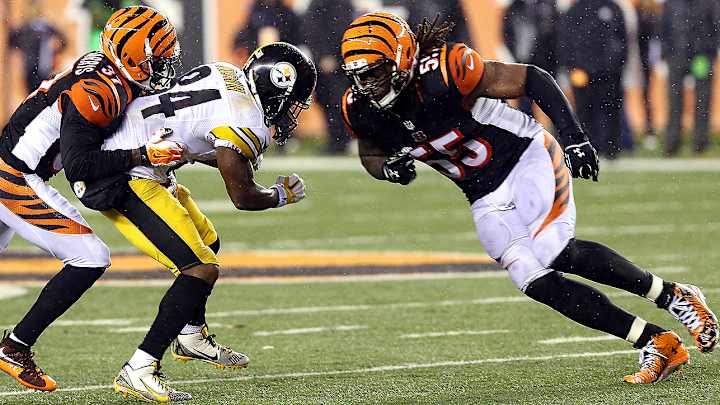The NFL Should Consider Banning Vontaze Burfict

Vontaze Burfict, the Bengals linebacker known for violent collisions, is back at it, delivering three blows to the head against his nemesis Pittsburgh Steelers last Sunday. One of those blows—an elbow to the head of Steelers star wide receiver Antonio Brown—looks awfully similar to a shot he laid on Brown almost three years ago in the playoffs. The league has repeatedly fined and suspended Burfict for these and other actions, including twisting the ankles of downed opponents and striking standing opponents in the testicles. Still, he returns, unapologetic, and continues to play with the intent to injure.
Time to start talking about a long-term ban for Vontaze Burfict. pic.twitter.com/qH7WuAo3TI
— robertklemko (@RobertKlemko) October 16, 2018
How did we get here, in the age of ‘player safety’? How does a player like Vontaze Burfict, who continually puts other players at unnecessary risk with violent and prohibited play, somehow stay on the field?
Glad you asked. First, you have to have a completely unrepentant human who lives in his own reality and has no problem maiming others for the purposes of winning a football game, or, in the case where he costs his team yards and points, simply exerting his will. That's Burfict. He thinks he’s straddling the line of decency, as he told The MMQB’s Andy Benoit last year. And he doesn't intend to change his game, as he told Bleacher Report’s Tyler Dunne two years ago. He is, at best, a remarkable athlete without a conscience, but he’s only a small part of the formula required for the NFL’s Vontaze Burfict Problem.
Also, you’ve got to have a head coach who coddles the player and defends him at every turn. Enter Marvin Lewis, the Bengals coach with unfathomable job security, who consistently makes excuses for Burfict’s actions. “Everybody makes comments on everything No. 55 does,” Lewis said Monday after the Steelers game. “They don’t comment on anything anybody else does. Let’s just leave it at that.”
A year ago in August, after Burfict again found himself under scrutiny for dirty play, Lewis insisted his middle linebacker had corrected his ways. “In my opinion Vontaze has changed,” Lewis said. “He’s learned. He’s changed. But he's a 250-pound man who hits like dynamite, like a cement truck.”
Burfict hasn’t changed because he doesn’t want to change—he’s said as much. But Lewis will continue to say that because it sounds nice for the cameras. The head coach has become an expert at appearing concerned about Burfict's dangerous play yet doing nothing at all to curtail it.
Next, you need to have a weak locker room culture with no vocal leadership. Winning locker rooms with established vets typically police themselves before coaches ever get wind of an issue, but the Bengals are way beyond that point with Burfict. Burfict’s play has cost his team in big moments—the 2016 hit on Brown put the Steelers in field goal range and cost the Bengals an elusive playoff victory—yet his transgressions continue, unabated. A locker room with a winning culture would have at least one veteran leader who could and would say to Burfict, in no uncertain terms, that dirty play will no longer be tolerated. Don't believe me? Here’s Ray Lewis—who knows nothing if not how to command a locker room—on Burfict, in 2016: “For me, as a teammate, I’m going to him and saying, ‘If this ever happens again, we have a personal problem.’ If it doesn’t come from the core, and Marvin has to defend you every time, then you’re going to think this tough guy mentality survives, and it really doesn’t.”
• VRENTAS: Why Do NFL Defenses Seem Helpless and Hopeless in 2018
So you’ve got the unrepentant violator, your acquiescing head coach and your uncommitted locker room. We’re on our way, but we’re not done.
Integral to the Burfict nightmare is the NFLPA, which is contractually obligated to represent players in appeals for fines and suspensions, if the player chooses. But isn’t it also obligated to work for the larger purpose of the safety of its members as a whole? Perhaps Burfict’s rights as a union member should only extend so far as those of the next player he stomps, kicks or spears. At some point, the union’s defense of Burfict comes at the expense of the health of other players. If the Players’ Association were to admonish Burfict the 30th time he led with his helmet or targeted the head in a collision with a defenseless player, it would send a message to players that safety for all is a priority over paychecks for one. Plus, it would give the NFL more freedom in punitive measures.
But who are we kidding? The NFL under Roger Goodell has consistently taken measures that fly in the face of collective bargaining when they feel the health of the league is at stake. And make no mistake—in the case of Burfict, it is. Set aside, for a moment, the NFL's stated obligation to player safety. In a strictly economic sense, the risk of a two-down linebacker in Cincinnati ending the career of a transcendent talent like Antonio Brown is unacceptable, especially if that player has shown no remorse for prior bad actions and no desire to reform.
That Burfict won’t face suspension for his actions on Sunday, as reported, and will likely suit up this Sunday against the Chiefs and their offensive huddle chock-full of rising stars, is simply mystifying to me. If he takes aim at the skull of one of those stars and unleashes 250 pounds of dynamite, there will be plenty of blame to go around.
